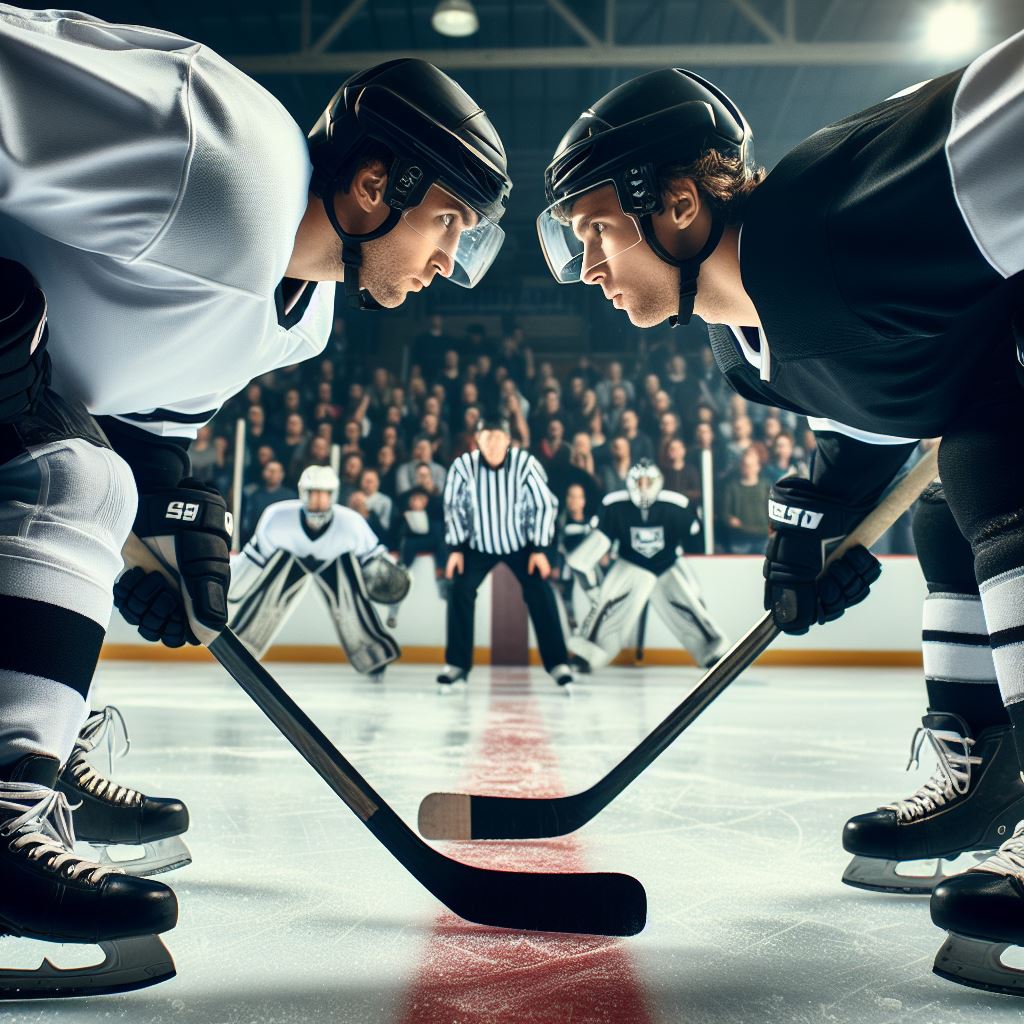Master the art of faceoff positioning in hockey to gain a competitive edge on the ice. Learn essential techniques and strategies for winning faceoffs and controlling the game. Elevate your skills and contribute to your team’s success with expert guidance.
Introduction
In the fast-paced world of hockey, mastering faceoff positioning hockey is crucial for gaining an edge on the ice. Whether you’re vying for control of the puck or aiming to thwart your opponent’s advances, understanding the nuances of proper positioning during faceoffs can make all the difference in determining the outcome of the game.
In this article, we’ll delve into the definition of faceoff positioning in hockey and highlight the importance of maintaining proper positioning during these critical moments of gameplay. So, lace up your skates and get ready to elevate your understanding of faceoff positioning in hockey to new heights.
What Is Faceoff Positioning Hockey?
The answer to “Faceoff Positioning Hockey” would be a comprehensive guide or discussion on the techniques, strategies, and importance of proper positioning during faceoffs in the sport of hockey. This would include insights into offensive and defensive faceoff positioning, the roles of different players such as centers, wingers, and defensemen, as well as drills, training methods, and overall team strategies aimed at maximizing success during faceoff situations on the ice.
Offensive Faceoff Positioning: Maximizing Scoring Opportunities
In hockey, offensive faceoff positioning is crucial for gaining control of the puck and initiating scoring opportunities. Understanding the roles of the center and wingers is essential for executing successful offensive strategies.
Center’s Role
Strategy for Winning the Faceoff
The center’s primary objective during offensive faceoffs is to win possession of the puck and kick-start the offensive play. To achieve this, centers utilize various strategies, including using their strength and technique to outmaneuver opponents and quickly gain control of the puck.
Positioning in Relation to Opponents
Positioning is key for centers during offensive faceoffs. They must anticipate the movements of their opponents and adjust their positioning accordingly to gain a strategic advantage. By staying low and maintaining a strong stance, centers can effectively block opponents and increase their chances of winning the faceoff.
Wingers’ Roles
Supporting the Center
Wingers play a crucial role in supporting the center during offensive faceoffs. They position themselves strategically to provide passing options and support the center in maintaining possession of the puck. By being ready to retrieve loose pucks or create scoring opportunities, wingers can help sustain offensive pressure following a successful faceoff win by the center.
Potential Offensive Tactics
Wingers are instrumental in executing offensive tactics immediately after a faceoff win. Whether it’s driving towards the net to create scoring chances or setting up for a one-timer, wingers must be prepared to capitalize on the momentum generated from winning the faceoff. By communicating effectively with the center and other teammates, wingers can execute coordinated plays and increase the likelihood of scoring goals.
By understanding and executing their respective roles effectively, centers and wingers can maximize scoring opportunities for their team during offensive faceoffs, ultimately contributing to the team’s success on the ice.

Defensive Faceoff Positioning: Strategies and Roles
In hockey, defensive faceoff positioning is paramount to thwarting opponents’ scoring attempts and maintaining control of the game. Understanding the roles of the center and defensemen is key to effectively executing defensive strategies.
Center’s Role
Defensive Strategies
When taking a defensive faceoff, the center plays a pivotal role in preventing the opposing team from gaining possession of the puck. They employ various defensive strategies, such as tying up the opponent’s stick or disrupting their movements to delay their attempt at winning the draw.
Anticipating Opponent’s Moves
Anticipating the opponent’s moves is crucial for the center during defensive faceoffs. By studying their opponent’s tendencies and positioning, the center can react quickly and effectively to counter their actions, increasing the likelihood of winning the faceoff.
Defensemen’s Roles
Protecting the Net
Defensemen are responsible for protecting their team’s net during defensive faceoffs. They position themselves strategically to block passing lanes and clear the puck out of the defensive zone if possession is gained by the opposing team.
Potential Defensive Tactics
Defensemen employ various defensive tactics during faceoffs, including boxing out opponents to prevent them from getting to the net, applying pressure to force turnovers, and communicating effectively with teammates to maintain defensive cohesion.
Mastering Faceoff Positioning Techniques for Hockey Success
Body Positioning
Effective body positioning is crucial for winning faceoffs in hockey. By utilizing proper stance and leverage, players can gain an advantage over their opponents and increase their chances of winning possession of the puck.
Stick Positioning
Strategic stick positioning is key to gaining control of the puck during faceoffs. By placing their stick in the right position and anticipating the puck drop, players can quickly react and gain possession, setting the stage for offensive plays or defensive clears.
Reading Opponents’ Tendencies
Understanding and reading opponents’ tendencies during faceoffs can provide players with a significant advantage. By studying their opponents’ body language and movements, players can anticipate their next move and adjust their own strategy accordingly, increasing their chances of success.
Mastering these faceoff positioning techniques requires practice, dedication, and attention to detail. By honing their skills in body positioning, stick placement, and reading opponents’ tendencies, hockey players can elevate their game and make meaningful contributions to their team’s success on the ice.
Adjustments and Adaptations: Keys to Hockey Success
In the dynamic sport of hockey, making timely adjustments and adaptations is crucial for staying ahead of the competition. Whether it’s changing strategies based on the game situation, counteracting opponents’ tactics, or the coach’s role in guiding adjustments, teams must be agile and responsive to maximize their chances of success on the ice.
Changing Strategies Based on Game Situation
Adapting strategies based on the game situation is essential for hockey teams to maintain momentum and seize opportunities. Whether leading, trailing, or tied, teams must adjust their gameplay to capitalize on strengths, exploit weaknesses, and respond to the evolving dynamics of the match.
Counteracting Opponents’ Tactics
Analyzing and counteracting opponents’ tactics is crucial for overcoming challenges and gaining a competitive edge. By identifying patterns, tendencies, and strategic maneuvers employed by the opposing team, players can adjust their approach to neutralize threats and capitalize on vulnerabilities, turning the tide of the game in their favor.
Coach’s Role in Guiding Adjustments
The coach plays a pivotal role in guiding adjustments and adaptations throughout the game adaptations throughout the game. Through strategic analysis, real-time feedback, and tactical instructions, the coach empowers players to make informed decisions, execute game plans effectively, and adapt to changing circumstances on the ice, ultimately maximizing the team’s potential for success.

Enhancing Hockey Skills Through Practice and Training
Drills for Improving Faceoff Positioning
Effective faceoff positioning drills are crucial for developing the necessary skills and techniques to win faceoffs consistently. By simulating game-like scenarios and practicing various faceoff strategies, players can improve their ability to anticipate opponents’ movements, gain leverage, and gain control of the puck.
Importance of Repetition and Muscle Memory
Repetition is key to developing muscle memory and mastering faceoff positioning. By regularly practicing faceoffs in training sessions, players can engrain proper techniques and reflexes, allowing them to execute with precision and confidence during game situations. Consistent repetition builds muscle memory, ensuring that players can perform under pressure and make split-second decisions instinctively.
Incorporating Faceoff Positioning into Overall Team Strategy
Integrating faceoff positioning into the overall team strategy is essential for maximizing its effectiveness on the ice. Coaches must emphasize the importance of winning faceoffs and incorporate specific faceoff plays and tactics into their game plans. By strategizing around faceoff wins, teams can gain possession of the puck, create scoring opportunities, and control the flow of the game.
By prioritizing practice and training, focusing on repetition and muscle memory, and incorporating faceoff positioning into overall team strategy, hockey players can enhance their skills and contribute to their team’s success on the ice. With dedication, hard work, and strategic preparation, players can elevate their game and achieve their goals in the fast-paced and competitive world of hockey.
FAQs
What is faceoff positioning in hockey?
Faceoff positioning in hockey refers to the strategic placement of players on the ice during faceoff situations. It involves positioning players, such as centers, wingers, and defensemen, to gain an advantage in winning possession of the puck when the game resumes after a stoppage. Proper faceoff positioning is crucial for gaining control of the puck, initiating offensive plays, or preventing the opposing team from gaining an advantage.
Why is mastering faceoff positioning important in hockey?
Mastering faceoff positioning is essential in hockey because it can significantly impact the outcome of the game. Proper positioning during faceoffs increases the team’s chances of winning possession of the puck, which is crucial for initiating scoring opportunities, controlling the game’s tempo, and ultimately contributing to the team’s success on the ice.
What are some key roles during offensive faceoff positioning?
During offensive faceoff positioning, key roles include the center’s responsibility to win possession of the puck and initiate offensive plays, the wingers’ role in supporting the center and creating scoring opportunities, and the coordination among teammates to execute offensive tactics effectively following a successful faceoff win.
How can players improve their faceoff positioning skills?
Players can improve their faceoff positioning skills through practice, repetition, and attention to detail. Engaging in drills specifically designed to simulate faceoff situations, focusing on body and stick positioning techniques, and studying opponents’ tendencies can help players enhance their ability to win faceoffs and contribute to their team’s success on the ice.
Conclusion
In conclusion, mastering faceoff positioning in hockey is not just about individual skill but also about teamwork, strategy, and adaptability. By understanding the nuances of offensive and defensive faceoff positioning, players can gain a competitive edge on the ice and contribute significantly to their team’s success.
Whether it’s winning possession of the puck, creating scoring opportunities, or thwarting opponents’ advances, proper positioning during faceoffs is a fundamental aspect of the game. Through dedicated practice, attention to detail, and strategic preparation, hockey players can elevate their skills, enhance their contributions to their team, and thrive in the fast-paced and competitive world of hockey.
